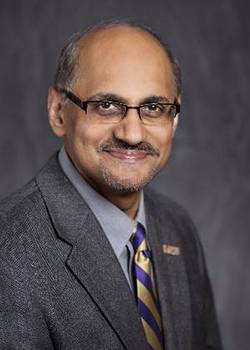Paper by LSU ChemE Professor Links Pollution to Virus Transmission
August 12, 2020
 BATON ROUGE, LA – For more than 20 years, LSU Chemical Engineering Professor Kalliat
T. Valsaraj’s research has focused on atmospheric aerosols and environmental behavior,
including investigating issues like India’s poor air quality for more than 10 years.
BATON ROUGE, LA – For more than 20 years, LSU Chemical Engineering Professor Kalliat
T. Valsaraj’s research has focused on atmospheric aerosols and environmental behavior,
including investigating issues like India’s poor air quality for more than 10 years.
But Valsaraj and his colleagues have turned their attention to a new problem in their recently published article in Environmental Research titled, “Potential Link Between Compromised Air Quality and Transmission of the Novel Corona Virus (SARS-CoV-2) in Affected Areas.”
Specifically, through a critical review of the current literature and a preliminary analysis of the link between transmission of the coronavirus and air pollution in affected regions, the research group writes that polluted environments could enhance the transmission rate of such deadly viruses under moderate-to-high humidity conditions. The aqueous atmospheric aerosols offer a conducive surface for adsorption/absorption of organic molecules and viruses onto them, facilitating a pathway for higher rate of transmission under favorable environmental conditions.
“Our work shows that air quality exacerbates the susceptibility of affected populations that are already immunocompromised due to inhalation exposure,” Valsaraj said. “Also, we believe that atmospheric aerosols are the main mechanism of transmission of the virus and hence, air quality, such as particulate matter pollution, temperature, and relative humidity affects the rates of transmission. This is a very important finding that is just being recognized by [the World Health Organization] and others.”
The group concludes the paper by cautioning that not all virus transmission routes can be ascribed to air pollution alone. Furthermore, it calls for the imperative attention of researchers from a variety of disciplines to address the problem of environmental influence on rapid transmission of pandemics, such COVID-19, and urges authorities to formulate stringent policies that could help curtail enhanced pollutant emissions.
Joining Valsaraj on the paper are M.G. Manoj and C. Sivan, of the Cochin University of Science and Technology’s Advanced Centre for Atmospheric Radar Research in India; M.K. Satheesh Kumar, of the Manipal Academy of Higher Education’s Department of Atomic and Molecular Physics in India; and Soumya K. Vijayan, of the Government Medical College’s College of Pharmaceutical Sciences in India.
Read the full paper by clicking here.
Like us on Facebook (@lsuengineering) or follow us on Twitter and Instagram (@lsuengineering).
###
Contact: Joshua Duplechain
Director of Communications